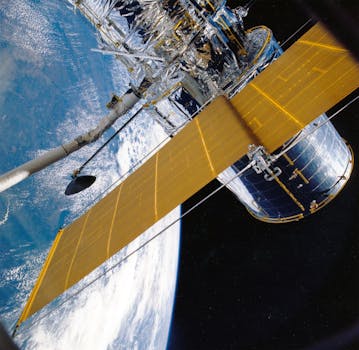MEO Satellites: The Future of Global Connectivity with Medium Earth Orbit Technology – MEO Satellites

MEO Satellites: The Future of Global Connectivity with Medium Earth Orbit Technology – MEO Satellites
MEO satellites, or Medium Earth Orbit satellites, are a type of satellite that orbits the Earth at an altitude of approximately 2,000 to 36,000 kilometers. This unique orbital position allows MEO satellites to provide faster and more reliable connectivity compared to traditional Geostationary (GEO) satellites. MEO satellites are poised to play a crucial role in the future of global connectivity, enabling faster and more efficient data transfer, voice communication, and other critical services.
The use of MEO satellites is becoming increasingly popular due to their ability to provide high-speed, low-latency connectivity. This is particularly important for applications that require real-time communication, such as video conferencing, online gaming, and financial transactions. Additionally, MEO satellites can provide connectivity to remote and underserved areas, where traditional terrestrial infrastructure may not be available.
How MEO Satellites Work
MEO satellites work by transmitting and receiving signals to and from Earth stations or other satellites. They use a variety of frequencies, including Ka-band, Ku-band, and C-band, to provide a range of services, including broadband internet, voice communication, and navigation. MEO satellites are typically equipped with advanced antennas and transponders, which enable them to provide high-gain and high-power signals, resulting in faster and more reliable connectivity.
One of the key advantages of MEO satellites is their ability to provide global coverage. By using a constellation of MEO satellites, operators can provide seamless and continuous coverage, even in areas where traditional GEO satellites may not be visible. This makes MEO satellites ideal for applications that require global coverage, such as maritime communication, aviation, and emergency response.
Advantages of MEO Satellites
MEO satellites offer several advantages over traditional GEO satellites. One of the main advantages is their lower latency. Because MEO satellites are closer to the Earth, they can provide faster signal transmission and reception, resulting in lower latency and faster data transfer. Additionally, MEO satellites can provide higher frequencies, which enable faster and more efficient data transfer.
Another advantage of MEO satellites is their ability to provide more precise navigation and timing signals. This is particularly important for applications that require high-precision navigation, such as aviation and maritime. MEO satellites can also provide more accurate weather forecasting and climate monitoring, which is critical for predicting and mitigating the effects of climate change.
Challenges and Limitations of MEO Satellites
While MEO satellites offer several advantages, they also pose some challenges and limitations. One of the main challenges is the complexity of launching and operating a constellation of MEO satellites. This requires significant investment and expertise, as well as careful planning and coordination. Additionally, MEO satellites are more prone to interference and signal degradation due to their lower altitude and higher velocity.
Another limitation of MEO satellites is their shorter lifespan compared to GEO satellites. Because MEO satellites are closer to the Earth, they are more susceptible to atmospheric drag and other environmental factors, which can reduce their lifespan. Additionally, MEO satellites require more frequent station-keeping maneuvers, which can increase their fuel consumption and reduce their overall lifespan.
Despite these challenges and limitations, MEO satellites are poised to play a crucial role in the future of global connectivity. With their unique orbital position and advanced technology, MEO satellites can provide faster, more reliable, and more efficient connectivity, making them an essential component of modern telecommunications.
In conclusion, MEO satellites are revolutionizing the way we communicate and access data globally. With their faster and more reliable connectivity, MEO satellites are poised to play a crucial role in the future of global connectivity, enabling faster and more efficient data transfer, voice communication, and other critical services. As the demand for global connectivity continues to grow, MEO satellites will become an increasingly important component of modern telecommunications.



